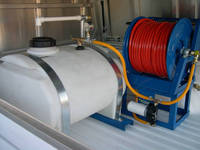With Power Sprayer Components - Start With The Tank
Posted by Andrew Greess on Jan 27, 2015
Tank size is critical. The first component of a power spray rig is the tank. Once tank size is determined, every other component can be selected. Tank size should be the largest one needed to support the average or expected daily workload. Select a tank large enough so a technician isn’t constantly refilling, which kills productivity and can annoy customers who don’t like vendors using the customer’s water. The tank must be small enough to fit in the truck and keep the load (weight of the water) within the truck’s safe handling capacity.
If the company doesn’t have the vehicle, use this formula to determine tank size:
(Average number of stops per day) x (average number of gallons applied per stop) + small safety margin = recommended tank size.
Example: The plan is to make 12 stops pa day and apply 5 gallons of product per stop. 12 stops x 5 gallons = 60 gallons plus a 5% safety factor (10% x 60 gallons = 3 gallons). The tank size should be at least 63 gallons. Tanks don’t come in 63-gallon sizes, so the next larger size is 65 gallons, which is your minimum starting point.
It’s better to have too many gallons than not enough. Having to stop to refill the tank will hurt productivity and often angers the customer whose water you’re using to fill the tank. Remember, a larger tank can always be partially filled if that’s all the day’s workload requires.
If the tank is 100 gallons, but the tech knows he’ll only need 50 gallons for the day’s work, fill the tank halfway, which is preferable to having a 50-gallon tank and having to refill it to finish the day’s jobs. This assumes the truck has the capacity (weight and space) to handle the tank.
If the company already has the vehicle, tank size might be limited. For example, don’t put more than 50 or 65 gallons in a compact pickup truck. Those who put too large a tank in a small truck pay for it by having to frequently replace brakes, tires, suspension and transmission.
Most power sprayer tanks are made from polyethylene, a form of plastic, fiberglass or metal (usually steel or aluminum). Pros and cons of each include:
Poly tanks

Pros:
It’s the least expensive type of tank.
It’s usually easy to see water level inside the tank.
They’re relatively cheap and easy to replace.
They can be plumbed from the top or bottom.
They’re usually manufactured by large companies and are available nationally.
Cons:
It might not last as long as other types of tanks.
Fiberglass tanks
Pros:
They’re durable
You can put advertising on the tank (e.g., phone number, company logo, etc.).
Cons:
They’re more expensive than poly.
They usually can only be plumbed from the top.
You can’t tell how much water is in tank unless a sight gauge is installed.
They often require a steel frame for support, which adds cost and weight.
They’re more difficult to replace. Because fiberglass tanks are made locally with a custom mold, they can only be replaced by the company that built them. If that company has changed tank shape or is no longer in business, the tank won’t be available, and it’s likely significant modifications to the sprayer will be required to install a replacement tank.
Metal tanks
Pros:
They’re the most durable.
They can be plumbed from the top or bottom.
You can put advertising on the tank (e.g., phone number, company logo, etc.)
Cons:
They’re the most expensive.
They can add considerable weight to the sprayer.
You can’t tell how much water is in the tank unless a sight gauge is installed.
They can get hot under the summer sun.
Qspray is a professional pest control and landscape equipment business you can trust. We offer decades of experience, industry expertise and we stock all the hard-to-find parts for your spray equipment. Learn more about Qspray today.

